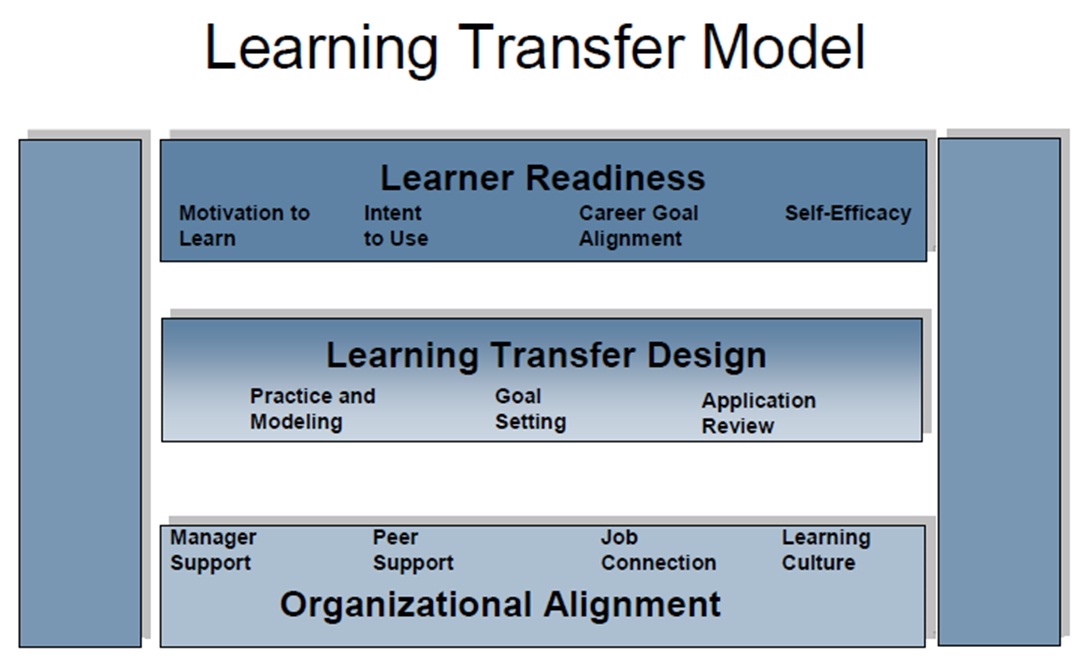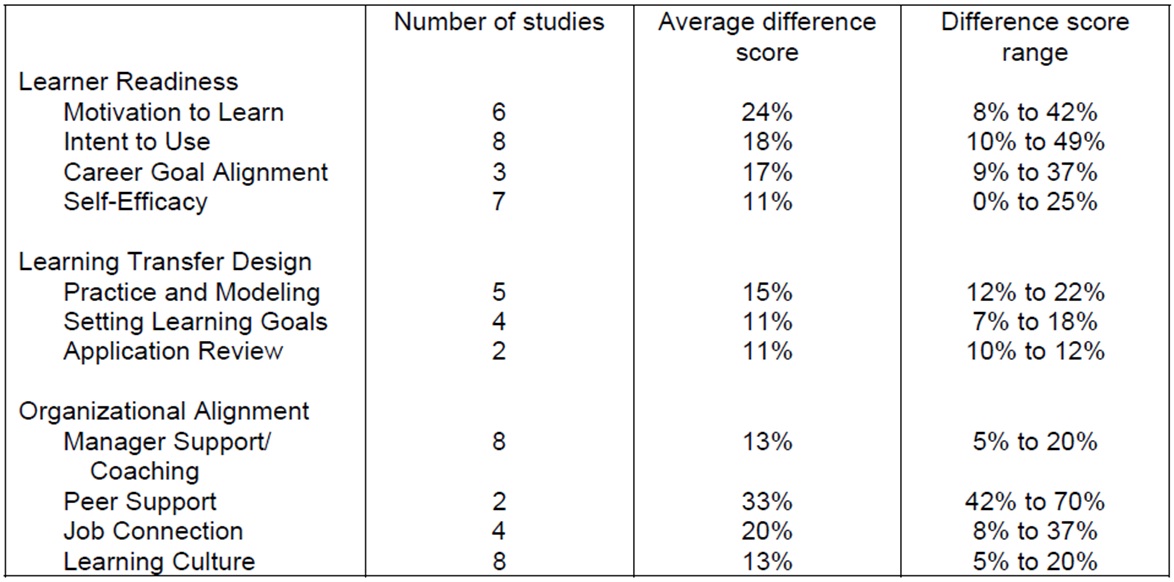Wilson Learning's Michael Leimbach concludes his study on the impact of learning transfer activities on an organisation’s performance.
The second part of this two part report presents a Learning Transfer model with 11 specific actions to improve performance outcomes, and increase training ROI, in your organisation. As described in Part 1 of this report, our research found that the learning transfer activities researched in 32 studies can be grouped into three primary categories.
- Learner readiness activities: These activities focus on ensuring that the learner is prepared for the core learning event. Activities that address motivation, learner goals, self-efficacy, and testing of prerequisite skills are included in this category.
- Learning transfer design activities: These are activities embedded in the instructional design that are intended to support learning transfer. Practice activities, role modelling, setting learning goals, and application review and support are examples.
- Organisational alignment activities: These activities focus on ensuring that the organisation supports the use of the skills. Activities here include manager coaching, peer support, connecting learning to the job, and creating a learning culture.
Within each primary category, three to four specific learning transfer activities have been subject to research and have been shown to have an impact on performance.

Impact of learning transfer on performance outcomes
The table below shows the percentage impact (difference scores) for the different categories of learning transfer activities. For each activity the table shows the number of studies that included that activity, average difference score, and the range of difference scores.

Learner readiness
Learner readiness addresses the preparation given to learners prior to engaging in a learning activity. While things like prerequisite skills and pre-work are important, research has focused on activities that prepare the learner psychologically and emotionally to learn. As a whole, the research suggests that addressing learner readiness can increase the effectiveness of learning transfer by as much as 70%.
- Motivation to learn: Activities that communicate the importance and value of learning to motivate the learner. This includes actions such as promoting lifelong learning, addressing learning anxiety, and overall helping the adult learner appreciate the value of learning.
- Intent to use: Of course, motivation to learn has less value if the learner does not intend to use the learning. This includes actions focused on helping learners integrate the learning into their work environment and work systems, and motivating them to practice using the skills they learn.
- Career goal alignment: Activities that help learners see how the skills align with their ultimate work and career goals. The more a learner sees the skills as valuable to his or her career progression, the more likely the skills will be used and have a positive impact on performance.
- Self-efficacy: Addressing the learner’s belief that he or she has the capacity to learn and that the learning will result in a meaningful change in performance.
Learning transfer design
Research has shown that how the learning process is designed also has an impact on the degree to which the learning will transfer to work performance. This is what we mean by learning transfer design. The three elements that have been researched, taken together, can enhance learning transfer by up to 37%.
- Practice and modelling: The more the learning design includes practice and behavioural modelling during learning, and the closer that practice and modelling replicate real-life situations (referred to as “fidelity” in the literature), the greater the transfer of learning to work.
- Setting learning goals: When learners set specific goals for their learning, either behavioural or performance goals, the likelihood increases that they will use the skills in their work.
- Application review: Extending the learning beyond the initial event by including content reviews and, more importantly, reviews of how to apply the skills to specific work tasks has also been shown to improve the impact of learning.
Organisational alignment
Finally, the transfer of learning also relies on the degree to which the organisation is aligned with and supports the learning and use of new skills. While a number of things can constitute 'organisational alignment', research has primarily investigated four.
- Manager support/coaching: Studies have shown that the more managers are trained in how to support and coach the skills their employees learn, the more those skills will be used and sustained in the workplace.
- Peer support: While manager support is seen as critical, research suggests that the support of learners’ peers may be equally or more important. While there have only been two studies, both studies show peer support to have a very high level of impact on improving learning transfer.
- Job connection: The clearer the link between the skills taught and the skills required of the job, and the more the skills are integrated into work processes and systems, the greater the transfer of learning to work. While this may seem obvious, the research suggests that this does not always happen.
- Learning culture: The degree to which the organisational culture supports change and the use of new skills has a significant impact on the transfer of learning to the work environment.
Recommendations
Not all learning transfer activities are needed in every learning environment. However, the research does indicate that all learning events can benefit from additional actions specific to supporting the transfer of learning to the workplace.
Our experience indicates that learning transfer activities need to be considered along with all other factors of any instructional design process. In the development and launch of any learning program, organisations should ask questions such as:
- How do we know the learner audience is ready for this learning event, and what is the best way to prepare them to learn and use the skills?
- How is goal setting included in the learning process?
- What forms of practice and modelling are best for this content and this learner audience?
- What kinds of learning review and application support are needed to ensure use of the skills after the learning event?
- What is the best way to align the organisation to support the use of the skills learned?
- Are managers and peers prepared to coach and support the application of the learning?
- Will the organisation’s culture support the use of learning, or will it be a barrier? How can the culture be altered if it is a barrier?
One approach we have taken with clients has been to help them build a 'Learning Transfer Balance Scorecard' to identify where they are supporting transfer, what the impact has been, and where they could do more to improve the return-on-investment of their learning.
Conclusion
Activities that enhance the transfer of learning into workplace performance will have an important impact on an organisation’s performance and can significantly increase the return-on-investment for training and development efforts. This study provides convincing evidence that learning transfer can have a tremendous impact on the effectiveness of learning. Indeed, results suggest that, if all of the techniques studied above were simultaneously implemented, the impact of learning could be increased by 186%. This research also suggests that the actions that need to be taken are relatively clear and easy to implement. A few key activities, appropriately timed, can have a tremendous impact on organisational performance and the sustainability of learning.
Michael Leimbach Ph.D. is head of research and development, Wilson Learning Worldwide








